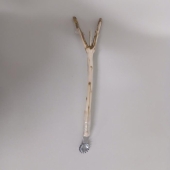


Rocket Mass Heater Plans: Annex 6" L-shaped Bench by Ernie and Erica
will be released to subscribers in:
soon!



 3
3




Smithsonian article: The Bittersweet Story of VanillaVanilla was cultivated in botanical gardens in France and England, but never offered up its glorious seeds. Growers couldn’t understand why until centuries later when, in 1836, Belgian horticulturist Charles Morren reported that vanilla’s natural pollinator was the Melipona bee, an insect that didn’t live in Europe.
Be the shenanigans
you want to see in the world.

 3
3




 1
1








I don't own the plants, they own me.
 1
1




K Eilander said, "What I want to know is: If pollinators are so important, is there a way of intentionally designing them into the system?

K Kaba said, "I think most of what you want, you're going to have to do the hard way on site. Permaculture in general has a huge advantage here, with the love of edge, and the push for observation.
The design aims to provide pollination support for farms and gardens, yields of nutritious fruits and nuts, valuable nesting sites for endangered native bees, and spectacular flower displays to shake off the winter blues
Flowers are an important source of food for insects such as bees, butterflies, wasps and hoverflies. Sugary nectar is an important source of carbohydrates, while pollen packs a powerful protein punch.
Planting flowers also attracts and sustains predatory insects.
Invasive plants are Earth's way of insisting we notice her medicines. Stephen Herrod Buhner
Everyone learns what works by learning what doesn't work. Stephen Herrod Buhner
 2
2










Skandi said, "plus host plants for the larval stages plus provide accommodation then the number of pollinators will go up, in a few years everything will be being pollinated again.
Invasive plants are Earth's way of insisting we notice her medicines. Stephen Herrod Buhner
Everyone learns what works by learning what doesn't work. Stephen Herrod Buhner
 2
2








Invasive plants are Earth's way of insisting we notice her medicines. Stephen Herrod Buhner
Everyone learns what works by learning what doesn't work. Stephen Herrod Buhner
 1
1




Finally! An Online Garden Master Course for permies!
How Permies.com Works



| I agree. Here's the link: http://stoves2.com |



